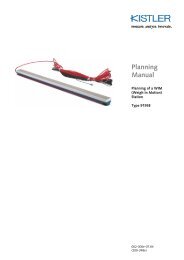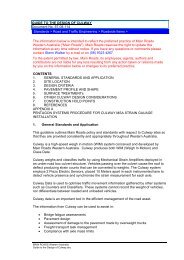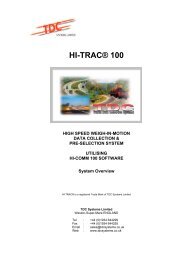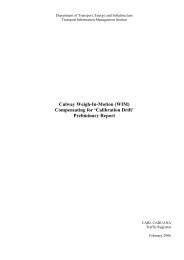AP-G84/04 Best practice in road use data collection, analysis ... - WIM
AP-G84/04 Best practice in road use data collection, analysis ... - WIM
AP-G84/04 Best practice in road use data collection, analysis ... - WIM
You also want an ePaper? Increase the reach of your titles
YUMPU automatically turns print PDFs into web optimized ePapers that Google loves.
Accessed by AR - ARRB TRANSPORT RESEARCH on <strong>04</strong> Feb 2005<br />
Aust<strong>road</strong>s 20<strong>04</strong><br />
— 35 —<br />
<strong>Best</strong> Practices <strong>in</strong> Road Use Data Collection, Analysis and Report<strong>in</strong>g<br />
Other RAs have also reported the <strong>use</strong> of <strong>data</strong>base technologies to facilitate <strong>data</strong> <strong>in</strong>tegration. The<br />
frameworks currently adopted (or be<strong>in</strong>g developed) <strong>in</strong> Queensland Ma<strong>in</strong> Roads and Ma<strong>in</strong> Roads<br />
WA represent examples of good <strong>practice</strong> <strong>in</strong> <strong>data</strong> <strong>in</strong>tegration.<br />
Many other opportunities are possible and can be exploited perhaps with private sector fund<strong>in</strong>g <strong>in</strong><br />
a public-private partnership arrangement (Section 5.3). Also, the many applications of <strong>road</strong> <strong>use</strong><br />
<strong>data</strong> necessitate consultation with various stakeholders, and this issue is addressed <strong>in</strong> Section 7.<br />
5.2 Correlation of Traffic Composition and <strong>WIM</strong> Data<br />
<strong>WIM</strong> sites can provide classified counts, gross vehicle masses and axle group masses, with some<br />
<strong>WIM</strong> systems also provid<strong>in</strong>g <strong>in</strong>dividual axle load <strong>in</strong>formation. <strong>WIM</strong> sites are ma<strong>in</strong>ly located on<br />
major freight corridors, and many of them are permanent sites, e.g. CULWAY sites. These<br />
count<strong>in</strong>g sites can be <strong>use</strong>d to calculate AADTs if all lanes of traffic are monitored. They can be<br />
treated as Pattern Stations, although they may not be at the best statistically representative<br />
locations. Short-term <strong>WIM</strong> sites can certa<strong>in</strong>ly provide an extra sample of counts to supplement<br />
current Short-term Stations. A good <strong>practice</strong> is therefore treat<strong>in</strong>g them as part of an <strong>in</strong>tegrated<br />
count<strong>in</strong>g program.<br />
An important issue is whether traffic composition at a count site can correlate with axle/vehicle load<br />
<strong>data</strong> at a nearby or related <strong>WIM</strong> site. In other words, the issue is whether it is possible to relate the<br />
tonnage of a heavy vehicle from its axle configuration us<strong>in</strong>g historical <strong>WIM</strong> <strong>data</strong>. Pearson and<br />
Foley (2001) identified a relationship shown <strong>in</strong> Table 16 from <strong>data</strong> collected at 16 CULWAY sites <strong>in</strong><br />
Victoria from 1995-1998 for two vehicle classes.<br />
Class 9 Articulated vehicle<br />
[0 00 000]<br />
Table 16 - Mean axle group and gross vehicle mass<br />
Mean mass (tonne)<br />
1995 1996 1997 1998<br />
Axle Group Mass 2 8.9 9.4 9.5 9.2<br />
Axle Group Mass 3 10.1 10.7 10.7 10.5<br />
Gross Vehicle Mass (GVM) 23.5 25.3 25.3 24.9<br />
Class 10 B-double<br />
[0 00 000 000]<br />
Axle Group Mass 2 8.6 9.5 9.5 9.3<br />
Axle Group Mass 3 9.7 10.8 10.9 10.7<br />
Axle Group Mass 4 9.2 10.4 10.4 10.2<br />
Gross Vehicle Mass (GVM) 32.0 35.9 36.0 35.6<br />
Table 16 shows that the average GVMs of the two vehicle types were 25 tonnes and 36 tonnes<br />
respectively. It is therefore possible to ga<strong>in</strong> an approximate <strong>in</strong>dication of the axle and gross vehicle<br />
load from particular axle configurations. However, further <strong>analysis</strong> of the heavy vehicle <strong>data</strong><br />
reported for the National Transport Commission (formerly the National Road Transport<br />
Commission, Ramsay et al. 2001) showed that the mass distribution for a particular vehicle class is<br />
not a normal distribution. Ramsay et al. reported that the <strong>data</strong> were compiled from the <strong>WIM</strong><br />
<strong>data</strong>bases of each State, totall<strong>in</strong>g some 29 million records of vehicle spac<strong>in</strong>gs and weights. The<br />
<strong>data</strong> were collected <strong>in</strong> the period 1993 to 2000, with predom<strong>in</strong>antly pre-1999 <strong>data</strong>.

















